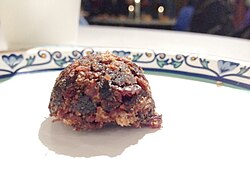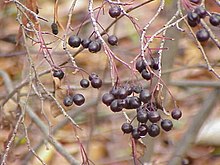Pemmican
 Pemmican ball | |
| Type | Agglomeration |
|---|---|
| Course | Main course |
| Place of origin | North America |
| Region or state | North America |
| Main ingredients | Bison, deer, elk or moose |
Pemmican (also pemican in older sources)[1][2] is a mixture of tallow, dried meat, and sometimes dried berries. A calorie-rich food, it can be used as a key component in prepared meals or eaten raw. Historically, it was an important part of indigenous cuisine in certain parts of North America and it is still prepared today.[3][4]
The name comes from the
Pemmican was widely adopted as a high-energy food by Europeans involved in the
.Ingredients

Pemmican has traditionally been made using whatever meat was available at the time: large
Among the Lakota and Dakota nations, there is also a corn wasná (or pemmican) that does not contain dried meat. This is made from toasted cornmeal, animal fat, fruit, and sugar.[13]
Traditional preparation

Traditionally, the meat was cut in thin slices and dried, either over a slow fire or in the hot sun until it was hard and
Today, some people store their pemmican in glass jars or tin boxes. The shelf life may vary depending on ingredients and storage conditions. At room temperature, pemmican can generally last from one to five years,[17] but there are anecdotal stories of pemmican stored in cool cellars being safely consumed after a decade or more.
A bag of bison pemmican weighing approximately 90 lb (41 kg) was called a taureau (French for "bull") by the Métis of Red River. These bags of taureaux (lit. "bulls"), when mixed with fat from the udder, were known as taureaux fins, when mixed with bone marrow, as taureaux grand, and when mixed with berries, as taureaux à grains.[18][self-published source?] It generally took the meat of one bison to fill a taureau.[19]
Serving
In his notes of 1874, North-West Mounted Police Sergeant Major Sam Steele recorded three ways of serving pemmican: raw, boiled in a stew called "rubaboo", or fried, known in the West as a "rechaud":[a]
The pemmican was cooked in two ways in the west; one a stew of pemmican, water, flour and, if they could be secured, wild onions or preserved potatoes. This was called "rubaboo"; the other was called by the plains hunters a "rechaud". It was cooked in a frying pan with onions and potatoes or alone. Some persons ate pemmican raw, but I must say I never had a taste for it that way.[20]
History
As bone grease is an essential ingredient in pemmican, archaeologists consider evidence of its manufacture a strong indicator of pemmican making. There is widespread archaeological evidence (bone fragments and boiling pits) for bone grease production on the
It has also been suggested that pemmican may have come through the
The

Trading people of mixed ancestry and becoming known as the
So important was pemmican that, in 1814, governor Miles Macdonell started the Pemmican War with the Métis when he passed the short-lived Pemmican Proclamation, which forbade the export of pemmican from the Red River Colony.[25]
Alexander Mackenzie relied on pemmican on his 1793 expedition from the Canadas to the Pacific.[26]
North Pole explorer Robert Peary used pemmican on all three of his expeditions, from 1886 to 1909, for both his men and his dogs. In his 1917 book, Secrets of Polar Travel, he devoted several pages to the food, stating, "Too much cannot be said of the importance of pemmican to a polar expedition. It is an absolute sine qua non. Without it a sledge-party cannot compact its supplies within a limit of weight to make a serious polar journey successful."[27]
British polar expeditions fed a type of pemmican to their dogs as "sledging rations". Called "Bovril pemmican" or simply "dog pemmican", it was a beef product consisting, by volume, of 2⁄3 protein and 1⁄3 fat (i.e., a 2:1 ratio of protein to fat), without carbohydrate. It was later ascertained that although the dogs survived on it, this was not a nutritious and healthy diet for them, being too high in protein.[28] Members of Ernest Shackleton's 1914–1916 expedition to the Antarctic resorted to eating dog pemmican when they were stranded on ice during the antarctic summer.[29]

During the
While serving as chief of scouts for the British Army in South Africa, American adventurer Frederick Russell Burnham required pemmican to be carried by every scout.[32]
Pemmican, likely condensed meat bars, was used as a ration for French troops fighting in Morocco in the 1920s.[33]
A 1945 scientific study of pemmican criticized using it exclusively as a survival food because of the low levels of certain vitamins.[34]
A study was later done by the U.S. military in January 1969, entitled Arctic Survival Rations, III. The Evaluation of Pemmican Under Winter Field Conditions.[35] The study found that during a cycle of two starvation periods the subjects could stave off starvation for the first cycle of testing with only 1000 calories worth of pemmican.[35]
Contemporary uses
Today, people in many indigenous communities across North America continue to make pemmican for personal, community, and ceremonial consumption. Some contemporary pemmican recipes incorporate ingredients that have been introduced to the Americas in the past 500 years, including beef. There are also indigenous-owned companies, such as Tanka Bar, based on Pine Ridge Indian Reservation in South Dakota, that produce pemmican or foods based on traditional pemmican recipes, for commercial distribution.
See also
- Kanemochi, also called "butter mochi" (バター餅), a similar high caloric density food invented by Japanese matagi hunters
- Alaskan ice cream
- Food drying
- Forcemeat
- Jerky
- Mincemeat
- Nutraloaf
- Pastirma
- Smoked fish
- Smoked meat
- Tolkusha
- Viande fumée
Notes
- ^ also spelled richeau, rasho, richot, rouchou, rousseau, rusho(o), rowshow, etc. see, http://dchp.ca/DCHP-1/entries/view/richeau
References
- ^ Ballantyne, Robert Michael (1876). Away in the Wilderness. Philadelphia: Porter & Coates. pp. 81–84.
- ISBN 9780919864290.
- ^ "Wo Lakota Making Wasna". Lakota Red Nations. 2017-11-30. Retrieved 2018-09-17.
- ^ "NANF". www.tankabar.com.
- ^ Sinclair, J.M. (ed) English Dictionary Harper Collins: 2001.
- ^ "Native Recipes". sacred.indigenous.youth.education.circle.mysite.com.
- ^ "New Lakota Dictionary Online". www.lakotadictionary.org. Retrieved 2020-02-12.
- ISBN 978-1580089357.
- ISBN 1894663667.
- ^ S2CID 130451803.
- ISBN 978-0816699797.
- ISBN 9780313376269.
- ^ Goodwin, Janice. "Healthy Traditions: Recipes of our Ancestors" (PDF). National Center for Native American Aging at the Center for Rural Health, University of North Dakota School of Medicine & Health Sciences. Retrieved 2020-02-12.
- ^ Gladue, Ian. "Interviewed with owner of Pânsâwân Dry Meat". CBC Radio. Radio Active. Retrieved 2019-01-29.
- ISBN 978-1-57912-221-8Black Dog & Levanthal. p. 107
- ^ "Pemmican Recipes". Alderleaf Wilderness College. Retrieved 2019-02-23.
- ^ "How Long Does Pemmican Last (GUIDE)". Ultimate Prepping. 2017-05-27.
- ^ Barkwell, Lawrence J. "How the Metis make pemmican". Retrieved 2013-01-24.
- OCLC 5035707.
- ISBN 978-1-55050-317-3.
- S2CID 163282801.
- S2CID 233744039.
- ^ ISBN 0-8032-8790-9.
- ^ O'Brien, Sam, "How to Make a 5,000-Year-Old Energy Bar", Atlas Obscura, April 30, 2020
- ISBN 9781553650775.
- ]
- ^ Peary, Robert E. (1917). Secrets of Polar Travel. Century Company. pp. 77–83.
- S2CID 129952806.
- ^ Alfred Lansing (1969), Endurance, New York: McGraw Hill, Library of Congress Catalog Card Number: 58-59666
- OCLC 989807.
- OCLC 989807.
- OCLC 407686.
- ^ Rupert Furneaux, Abdel Krim, p.177
- .
- ^ S2CID 252701647.
